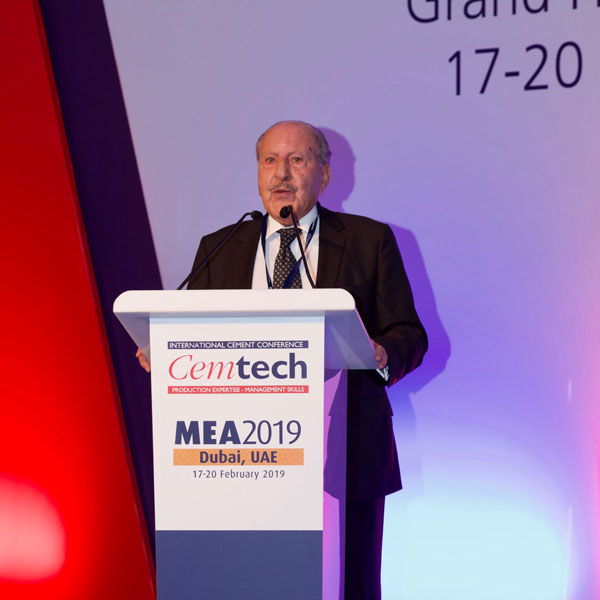Over 200 delegates from the global cement industry have come together for Cemtech Middle East & Africa 2019, which is being held at the Grand Hyatt Dubai, UAE, between 17-20 February.
International Cement Review's Managing Director, Thomas Armstrong, inaugurated the conference by welcoming delegates to Dubai. Mr Armstrong considered how oversupply is one of the largest issues that dominates the cement sector in the Middle East and African region, with a 55-60 per cent utilisation rate in 2017. Possible solutions for this issue include the export of cement and the optimisation of facilities. In particular, optimisation is a key focus of the event programme, with a break-out session delivered by INFORM (Germany) and a presentation on utilising AI for this purpose by McKinsey & Co (Germany).

Ahmad Al-Rousan, Secretary General of the Arab Union for
Cement and Building Materials (AUCBM) welcomes delegates
to Cemtech Middle East & Africa at the Grand Hyatt Dubai, UAE
Following this, Eng Ahmad Al-Rousan, Secretary General, Arab Union for Cement and Building Materials (AUCBM) delivered a welcome address for the event. Mr Al-Rousan noted that Cemtech MEA "is coming in a time when the cement industry is facing a very big change and big problems." In total, member countries have 175 integrated plants and over 30 grinding mills, delivering a cement capacity of 353Mta. However, actual production for 2018 was 240Mt. One of the major factors contributing to this supply-demand gap are the ongoing wars in some of its member countries. Finishing, Mr Al-Rousan stated this 'this conference is very important to exchange experience and to discuss all of these problems [...] and to see what we want to happen in the future'.
Paul Roger, Exane BNP Paribas (UK), opened the main conference programme with an outlook of global cement markets over the 2019-22 period. Mr Roger outlined some of the most important issues that producers will face in the medium-term including the impact of new sustainability regulations, Chinese expansion with Anhui Conch looking to expand overseas, equipment suppliers reducing barriers to entry and consolidation after mergers like Lafarge-Holcim and Heidelberg-Italcementi have reshaped the industry in key markets.
Tony Hadley delivered an analysis and outlook of the cement sector in sub-Saharan Africa. Providing an outlook of the issues of the sub-Saharan and north African cement sector, Mr Hadley reflected that previously "we have talked about the turmoil and that has probably come to a head in many parts of Africa." In emerging markets, large overcapacity has led to some producers altogether leaving the market and moving to more developed regions. Furthermore, larger multinationals are expected to move away from mergers and acquisitions to focus on internal strategies.
Hettish Karmani, U-Capital (Oman), looked at corporate performance in GCC markets and gave an outlook for the region in 2019. In terms of economic performance, the GCC region is expected to record around 3.9 per cent GDP growth in 2019. While total installed capacity of the cement sector is still expected to increase slightly, as a whole capacity growth is expected to slow considerably as a result of oversupply. Demand is expected to show minor growth compared to 2018 and reach 81Mt in 2019.
DG Khan's Arif Bashir (Pakistan) presented a case study of the construction and commissioning of Pakistan's largest cement facility at 9000tpd. Alongside this project, cement capacity in the country is expected to rise from 48Mta in 2018 to 63.26Mta in 2019. Providing a background for the new capacity, Dr Bashir stated that the reason the "cement industry is growing in the country is because there are a lot of interesting projects coming up", with China alone investing around US$68bn for new infrastructure projects.
Pritish Devassy, Al Rajhi Capital (Saudi Arabia), provided an economic context for the cement sector in Saudi Arabia and considered methods which could stabilise the industry in the country, such as shutting down old capacity alongside mergers and acquisitions. However, Mr Devassy also suggested that it may be more profitable to start a new company, rather than buying an established one through the open market. Finally, although it would likely be financed by players external to the country, planned mega-projects such as Neom provide a positive outlook for cement demand.
The final session of the day moved away from evaluating the regional markets, with ASEC’s Ayman Hassan (Egypt) exploring the possibilities for monitoring and controlling cement mill vibration. Further along the production process, Markus Horstkötter (Haver & Boecker) showed the company's innovative solutions which aim to move packaging technology into the future. Meanwhile, Olaf Michelswith (InterCem Engineering) highlighted the potential of Europe's first network of regional modular grinding plants. Finally, Javier Martinez Goytre of GlobBULK Consulting (Spain) compared light assets and traditional shiploading facilities for clinker exports.
The programme is scheduled to continue with a series of presentations outlining the latest developments in manufacturing technology from the leading industry equipment suppliers, including Gebr Pfeiffer looking at the construction of turnkey EPC grinding terminals and FLSmidth highlighting its latest kiln firing technology.
The conference programme will finish on Wednesday, 20 February with a plant tour to Arkan Building Materials' 4.5Mta facility in Al Ain.
